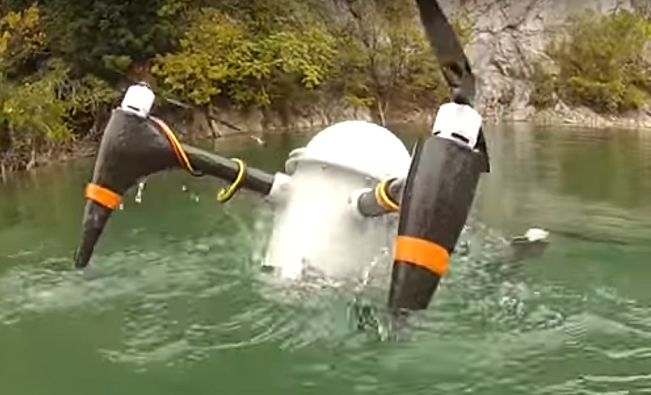CRACUNS

JPL APL Image
CRACUNS (Corrosion Resistant Aerial Covert Unmanned Nautical System) is a submersible UAV developed at John Hopkins University Applied Physics Laboratory.
John Hopkins APL Introduces a Submersible Unmanned Aerial Vehicle
17 March 2016 - Researchers at the Johns Hopkins University Applied Physics Laboratory in Laurel, Maryland, have developed an innovative unmanned aerial vehicle (UAV) that can stay on station beneath the water, then launch into the air to perform a variety of missions.
The Corrosion Resistant Aerial Covert Unmanned Nautical System — or CRACUNS — is a submersible UAV that can be launched from a fixed position underwater, or from an unmanned underwater vehicle (UUV). A team from APL’s Force Projection Sector worked with fabrication experts in the Research and Exploratory Development Department to create a new type of unmanned vehicle that can operate effectively in two very different arenas: air and water.
“Engineers at APL have long worked on both Navy submarine systems and autonomous UAVs,” said Jason Stipes of APL’s Sea Control Mission Area, project manager for CRACUNS. “In response to evolving sponsor challenges, we were inspired to develop a vehicle that could operate both underwater and in the air.” The resulting CRACUNS prototype system was developed and tested using internal research and development funding.
CRACUNS enables new capabilities not possible with existing UAV or UUV platforms. Its ability to operate in the harsh littoral (shore) environment, as well as its payload flexibility, enables a wide array of potential missions.
The most innovative feature of CRACUNS is that it can remain at and launch from a significant depth without needing structural metal parts or machined surfaces.
To make that possible, the team needed to overcome two big challenges. First, the APL team leveraged advances in additive manufacturing and novel fabrication techniques available at the Laboratory’s extensive fabrication facilities. The team fabricated a lightweight, submersible, composite airframe able to withstand the water pressure experienced while submerged.
The second significant challenge was to ensure CRACUNS could not just survive, but operate effectively in a corrosive saltwater environment. To do that, the APL team sealed the most sensitive components in a dry pressure vessel. For the motors that are exposed to salt water, APL applied commercially available protective coatings. The team tested the performance of the motors by submerging them in salt water. Two months later, they showed no sign of corrosion and continued to operate while submerged.
“CRACUNS successfully demonstrated a new way of thinking about the fabrication and use of unmanned systems,” said APL’s Rich Hooks, an aerospace and mechanical engineer who was responsible for the novel additive manufacturing techniques used on CRACUNS.
CRACUNS gives sponsors and researchers access to possibilities that were previously unavailable. CRACUNS’ low cost makes it expendable, allowing for the use of large numbers of vehicles for high-risk scenarios.
“APL’s culture of innovation and mission-ready solutions continues to deliver success for our sponsors,” said Sea Control Mission Area Executive Christopher Watkins.